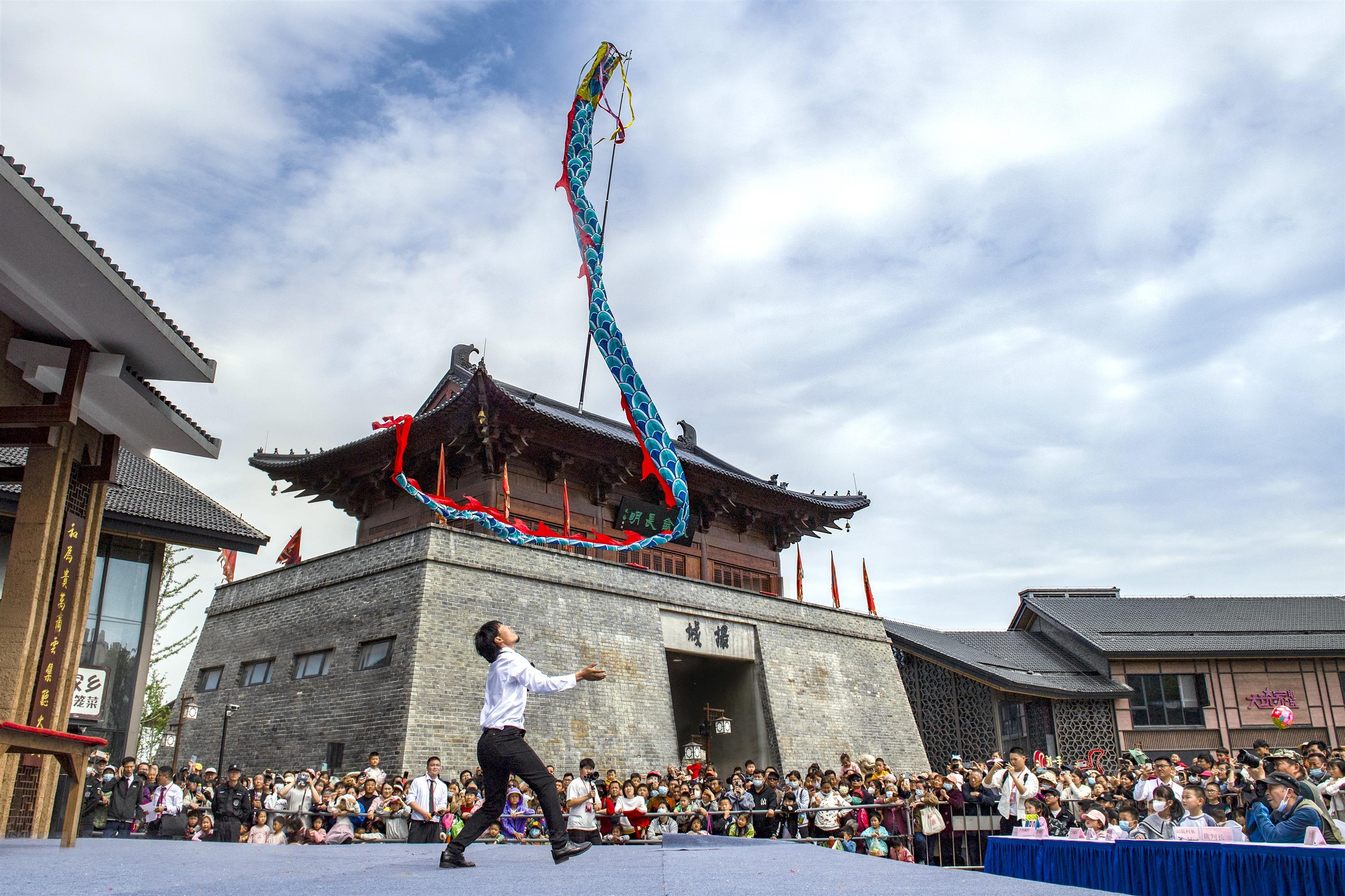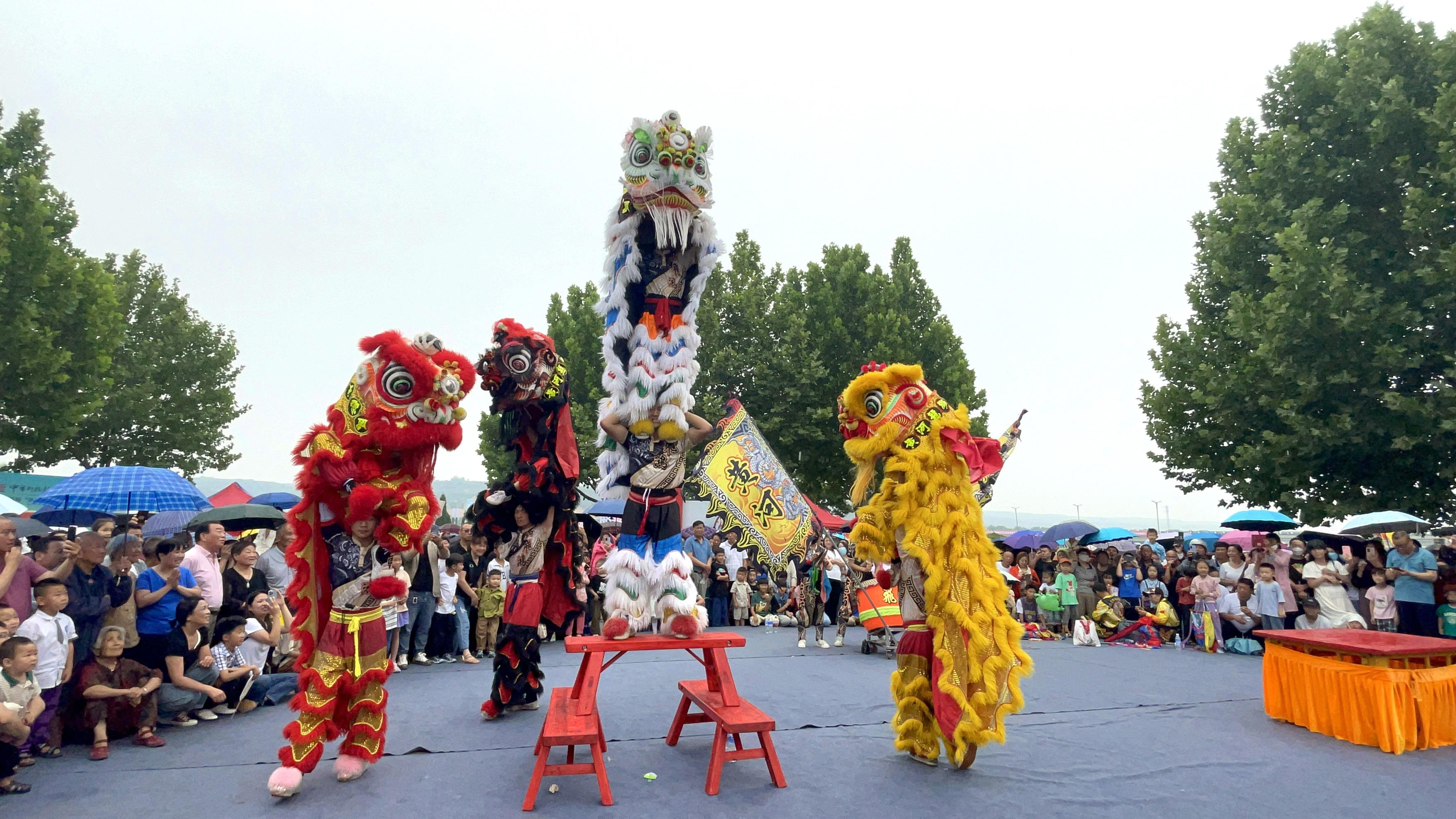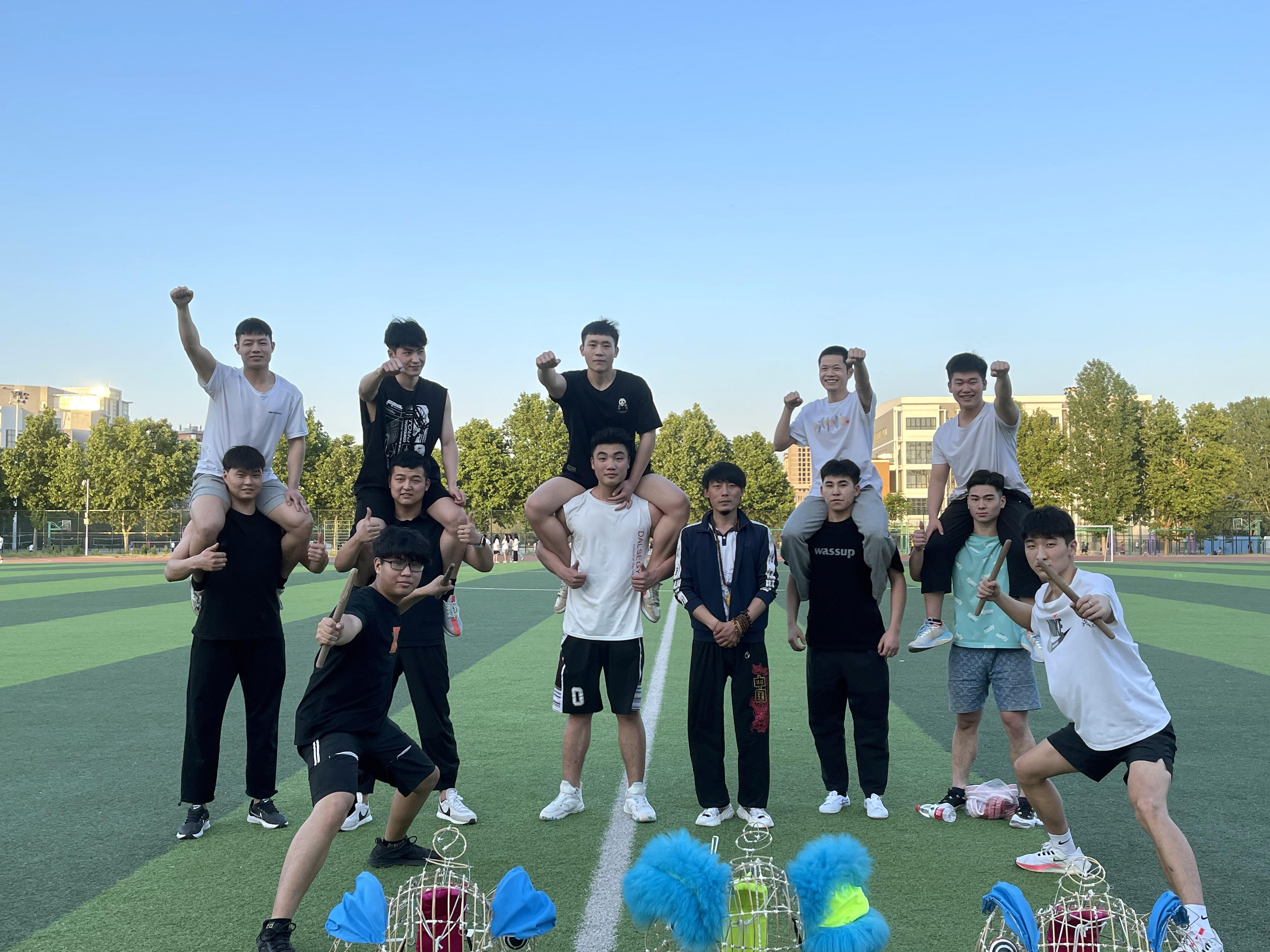Expertise and various cultural elements combine to add to the spectacle and attract new enthusiasts, Yang Feiyue reports.
 Yang Feilong, a young inheritor of Henan province's Xitao town, performs flying dragon dance in Hefei, Anhui province. (PHOTO PROVIDED TO CHINA DAILY)
Yang Feilong, a young inheritor of Henan province's Xitao town, performs flying dragon dance in Hefei, Anhui province. (PHOTO PROVIDED TO CHINA DAILY)
The lively and robust beat of gongs and drums from Yang Feilong's training facility can be heard more than a kilometer away.
As the door is pushed open, the sound floods the air and is abruptly overwhelming, while a group of young people dressed in multicolored lion-shaped costumes jump into view.
They nimbly move on the densely arranged iron piles, fixed to the ground, of varying heights, while completing agile flips and twists to showcase an extraordinary performance that exudes the charm of local folk culture.
Through their maneuvers, the dancing lion takes on a life of its own, displaying a variety of poses, from sitting and crouching to drinking water and licking its tail.
"The key lies in cooperation among the performers," says Yang, who observes the lion dance practices and gives his instructions.
"You also have to know how to exert force and put your heart into the performance, so the lion can be presented in a way that it looks real," adds Yang, who was recently named a model young inheritor of lion dance in Xitao town, Wuzhi county, Jiaozuo city, Central China's Henan province, by the provincial intangible cultural heritage protection center.
The show requires everyone to play their role to the full.
For actors in the lion head part, they have to be agile and deliver rich facial expressions.
"They must be capable of imitating the lion's suspicion, joy, anger and other traits with lifelike accuracy," Yang says.
Those in the tail have to be strong, since they often have to lift people at the head which, if not done properly, can make the performance appear rigid and sluggish, he explains.
"The tail controls the overall range of motion of the lion dance," Yang says.
There is an ancient tradition in China of dancers wearing masks to resemble animals or mythical beasts.
A popular legend about the origin of the lion dance suggests that, before the Han Dynasty (206 BC-AD 220), due to the Silk Road, a few lions had reached the Central Plains from the western area of ancient China.
At that time, people mimicked the appearance and actions of the newly arrived lions in a performance that later evolved into the lion dance, which became popular during the Tang Dynasty (618-907).
After that, the lion dance became synonymous with traditional, cultural and religious festivals, such as Chinese Lunar New Year. It has also spread abroad, as overseas Chinese established lion dance clubs to celebrate their traditional events in foreign lands.
 Yang and his team perform a Xitao lion dance in Gongyi city, Henan province. (PHOTO PROVIDED TO CHINA DAILY)
Yang and his team perform a Xitao lion dance in Gongyi city, Henan province. (PHOTO PROVIDED TO CHINA DAILY)
To date, the lion show is divided into southern and northern schools. The northern lion's appearance mostly resembles a real creature, with a lion head. The southern takes inspiration from opera facial styles, featuring vibrant colors and meticulous craftsmanship.
The Xitao lion dance falls into the northern category. It was founded during the Qing Dynasty (1644-1911) by Yang's family, whose ancestors were martial arts experts.
They developed their own lion dance troupes and integrated their martial arts movements into the dance, which evolved to have its own characteristics.
In the 1990s, Yang's grandfather set up a martial arts school in the town, and students were selected to perform lion dances during major celebrations.
It exposed Yang to the distinctive dance at an early age.
"When I saw the lion dancers galloping on the high piles, I was itching to try it myself," Yang recalls.
In 2001, his grandfather led a team of more than 20 students to engage in a martial arts exchange in Guangdong province, where he saw the southern-style lion dance, which was more standardized and, he felt, had a certain panache.
It prompted him to look into it, so he sent eight trainees, including Yang, to one of the biggest lion dance schools in Guangdong in 2003.
Yang says it was a bittersweet experience.
"It was hard to be away from home for my age, and the training was really difficult," Yang recalls.
They spent two to three hours practicing the dance skills while giving martial arts performances at local scenic spots to cover their living costs.
"We would deliver up to four martial arts shows every day, each for 40 to 50 minutes, and then continue practicing the lion dance when we returned to our accommodation," he says.
Only he and a few other trainees managed to complete the 6-year course.
The plus side, however, was that he had the lion dance down to a fine art after all those years of practice.
In 2008, when he returned home, more than 200 of his fellow villagers, including his whole family, rolled out the red carpet in welcoming him back.
He says it gave him an added sense of responsibility to upgrade the local lion dance.
That same year, Yang founded his own lion dance troupe.
He further integrated the northern lion dance elements, which highlight martial arts, with the more diverse costumes and cerebrating vibes of the southern style.
Yang has reinforced the characteristics of the Xitao lion dance.
"The movements in the routine are based on a martial arts horse-riding stance, making the performance appear even more vigorous and powerful," Yang says.
 Yang (on his own, center) poses for photos with lion and dragon dance students at a vocational school in Jiaozuo, Henan. (PHOTO PROVIDED TO CHINA DAILY)
Yang (on his own, center) poses for photos with lion and dragon dance students at a vocational school in Jiaozuo, Henan. (PHOTO PROVIDED TO CHINA DAILY)
Its representative moves include the seemingly dangerous leaping on narrow piles, as well as pole climbing and drumming, Yang says.
After three months of trial and error, in 2010, he was satisfied that the village's dance moves on the piles were up to the national standard.
The preparation enabled Yang's troupe to bring the house down at Wuzhi county's Spring Festival gala and was officially proclaimed an excellent show by the county in 2012.
It opened a new chapter for Yang's lion dance performance.
He has received many invitations to perform nationwide.
To date, his troupe gives about 500 performances a year for business openings, special celebrations or wedding ceremonies.
Under Yang's guidance, local lion dance societies were established to draw in young people.
To popularize the art form, Yang has led his team to take part in various competitions and won multiple awards, including first prize at the Henan folk sports competition from 2016 to 2019.
In the interim, he also worked with folk artists and jointly delivered an innovative flying dragon show that won first prize at the 13th National Dragon and Lion Dance Championships in 2021.
Built on the traditional dragon dance, it uses a redesigned main body, which has a cylindrical shape, creating a three-dimensional and lifelike appearance.
The performers wield a long pole to make the dragon airborne and move gracefully, as the dragon's body from head to tail is inflated with air.
"We have established a system as to how long a pole should be for different lengths of a dragon, while ensuring the pole is strong enough to hold the dragon and keep its appearance true to life," Yang says.
It features martial arts movements and integrates Chinese dragon culture.
Due to its relatively easy operation, Yang has also been actively promoting it as a physical fitness activity for the public. He has founded more than 100 dragon flying training facilities across the country, including in Shanxi, Shaanxi and Shandong provinces, as well as the Inner Mongolia autonomous region.
So far, those facilities have registered about 10,000 members annually, many of whom are middle school students, Yang says.
The flying dragon has, in turn, added to the charm of the Xitao lion dance.
Wang Rong, a local resident, still vividly remembers the stunt Yang pulled for a provincial Spring Festival gala in Xitao in January.
"The sheer scale alone was stunning," Wang says, adding that the number of dancing lions and flying dragons were too many for her to keep track.
"Explosive applause broke out at very close intervals, which added to the festivity," she adds.
Now, the simultaneous display of frolicking lions on the ground and flying dragons along the banks of the Yellow River has become a distinct feature of Yang's troupe's performance.
"They have been a carrier of spiritual culture and the embodiment of wisdom belonging to the working people living in the Yellow River Basin, and thus a part of the Yellow River culture," Yang says.
He considers it of extraordinary significance to perform on the banks of the Yellow River.
"I'd like to ensure the traditional dragon and lion culture gets carried forward, so that it can be embraced and recognized by more people," Yang says.
Contact the writer at yangfeiyue@chinadaily.com.cn



